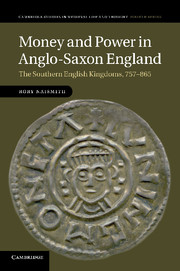Book contents
- Frontmatter
- Contents
- Figures
- Maps
- Tables
- Acknowledgements
- Abbreviations
- Chapter 1 Introduction
- Chapter 2 Money in its political context
- Chapter 3 Looking at coinage: iconography and inscriptions
- Chapter 4 Authority and minting I: the king
- Chapter 5 Authority and minting II: mints, die-cutters and moneyers
- Chapter 6 Value judgements: weight and fineness
- Chapter 7 Production of coinage
- Chapter 8 The circulation of coinage
- Chapter 9 The nature of coin-use in the early Middle Ages
- Chapter 10 Conclusion
- Bibliography
- Index
Chapter 3 - Looking at coinage: iconography and inscriptions
Published online by Cambridge University Press: 07 October 2011
- Frontmatter
- Contents
- Figures
- Maps
- Tables
- Acknowledgements
- Abbreviations
- Chapter 1 Introduction
- Chapter 2 Money in its political context
- Chapter 3 Looking at coinage: iconography and inscriptions
- Chapter 4 Authority and minting I: the king
- Chapter 5 Authority and minting II: mints, die-cutters and moneyers
- Chapter 6 Value judgements: weight and fineness
- Chapter 7 Production of coinage
- Chapter 8 The circulation of coinage
- Chapter 9 The nature of coin-use in the early Middle Ages
- Chapter 10 Conclusion
- Bibliography
- Index
Summary
Coins, kings and propaganda
The symbolic role of the currency as a statement of legitimacy and authority depended on its ability to answer to preconceived notions of how such qualities should be portrayed. It was the appearance of coinage that therefore secured its status as currency rather than as small pieces of bullion. Coin-users could and frequently did test the weight and purity of their money, but if the appearance of coinage satisfied their expectations these qualities were normally taken for granted. This was the point at which the visual demonstration of power intersected with the economic realities of day-to-day life.
Determining what these expectations were in eighth- and ninth-century England, however, depends solely on the extant coins and on examination of their iconographic and ideological background. There are no surviving statements about the appearance of money in England at this time in any written source: in discussing coin both Bede and the Anglo-Saxon Chronicle focused only on ancient and exotic gold pieces. Neither can it be assumed that all parties involved in the patronage, manufacture and use of coinage shared the same views and expectations of money and its appearance, or that these expectations remained static. Reconstructing the features of coinage Offa, Coenwulf, Æthelwulf and other rulers may have specified, and those which they were content to leave to the taste of the die-cutter, rests on the coins which happen to have been found in modern times.
- Type
- Chapter
- Information
- Money and Power in Anglo-Saxon EnglandThe Southern English Kingdoms, 757–865, pp. 47 - 86Publisher: Cambridge University PressPrint publication year: 2011



